The stonefish is known for being one of the most venomous fish genera in the world. Its potent venom targets its victims’ cell membranes, causing deterioration at the cellular level This often lowers the victim’s white blood cell count, causing infection even after the wound has been properly treated. As you can surmise from the name, the stonefish’s natural camouflage allows it to blend into rock formations and sediment, making it an unpleasant surprise for unwary divers. Left untreated, their venom is frequently fatal to humans.
Much like its namesake, the WE Stonefish from WE Knife Company is a nondescript fixed blade knife capable of reacting suddenly with lethality. The Stonefish is a medium-sized fixed blade, and is a mid-tier knife, coming in on the higher-end of the $100 to $300 price range. While manufactured in China, it’s worth noting that the Stonefish is actually American in origin, the production version of a custom knife called the Hornet designed by professional knife sharpener and Navy veteran Michael Emler who I’ve had the pleasure of meeting a few times. It’s a versatile blade, designed for hunting, survival, and general utility, as well as martial use.
Full disclosure: I purchased this knife with my own money, and have no qualms skylining any flaws I find. Let’s get to it, shall we?
Blade length: 4.46 in
Weight: 6.49 oz
Material: CPM-20CV stainless steel (blade), G10 (handle)
Unboxing
Founded by knife enthusiasts who placed a huge emphasis on quality, WE Knife Company got its start in 2000 in China, manufacturing OEM designs for other companies and designers before expanding into manufacturing their own high-end designs under their name and creating their Civivi brand for their lower-end designs. With a reputation for their extensive use of precision CNC machining, high-end materials, eye-catching designs, and uncompromising quality control, the company’s work is perhaps best summed up by its motto: “Made better.”
The WE Stonefish comes in a simple, sturdy, brown cardboard box. The first item to greet me was a small ziplock bag with a mini instruction and maintenance pamphlet, a WE Knife Company/Civivi sticker, and a microfiber cloth for cleaning the blade. Next to that bag was another small ziplock bag containing two rubber washers, two sets of Chicago screws, and a Dots clip, which is dimensionally similar to a large Blade-Tech Tek-Lok and is almost identical in form and function, with one main difference that we’ll cover later. Below that is a simple pancake-style black Kydex sheath, and at the very bottom of the box, the main attraction. Once removed from the protective plastic bag it’s wrapped in, the Stonefish is guarded by a plastic tip protector and a cardboard tube around the handle. The plastic bag around the blade is most likely there for rust protection during shipment, and the single silica gel packet at the very bottom of the box adds to that protection.
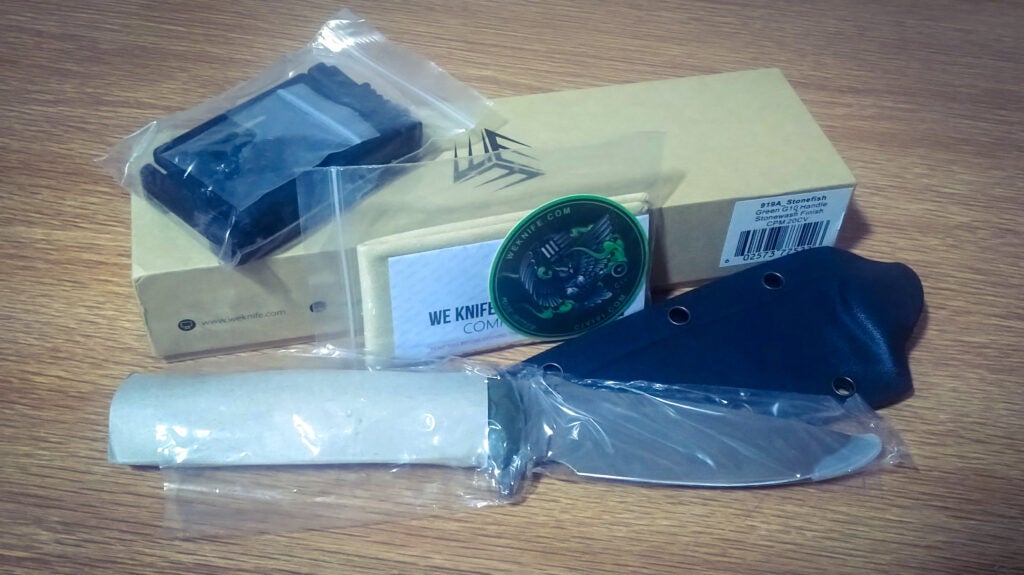
While it’s very similar to a Tek-Lok in form and function, the Dots clip has one notable difference: It has a ridged button that you depress to remove or attach the clip to your belt, and that can be slid to either side to lock or unlock the mechanism. The Tek-Lok instead has a set of two polymer wings that have to be squeezed together to remove it, and a pivoting latch to secure those during use. Having used both styles, the Dots clip is much easier to manipulate, especially for an everyday carry item; however, I can see it being a weak point out in the field, as the slightly more dextrous mechanism is likely to get jammed if sand or mud gets stuck in the button area. I haven’t had this issue yet, and don’t expect that it would be a catastrophic failure if it did, as the clip would simply be stuck and securely attached to your belt. Attaching the clip to the sheath was relatively easy: Simply choose how you’re going to orient the sheath, insert the threaded barrels through the inside of the Dots clip, place the included rubber spacers on the other side of the threaded barrels between the clip and the sheath, line the lock up with the correct holes on the sheath, and secure in place using the Phillips head screws. I set up the Kydex sheath for scout carry, where the sheath is horizontally oriented on my belt near the small of my back, allowing for a very low profile and quickly accessible tool.
Fitment on the 6 ?-inch long sheath was solid, with no discernable play between it and the blade. Retention was right in the sweet spot, where it’s not too tight to restrict accessibility, and it should break in nicely without becoming too loose. The sheath is nicely formed, with no noticeable imperfections and even, dehorned edges all around, and it was nice to see the inclusion of a small drainage hole near the tip of the sheath to help prevent the accumulation of moisture in more humid environments. The inner diameter of the grommets is a quarter-inch, which is a standardized size that will be compatible with a lot of the more common hardware out there, as well as allowing paracord to pass through easily if you need to lash it to your gear.
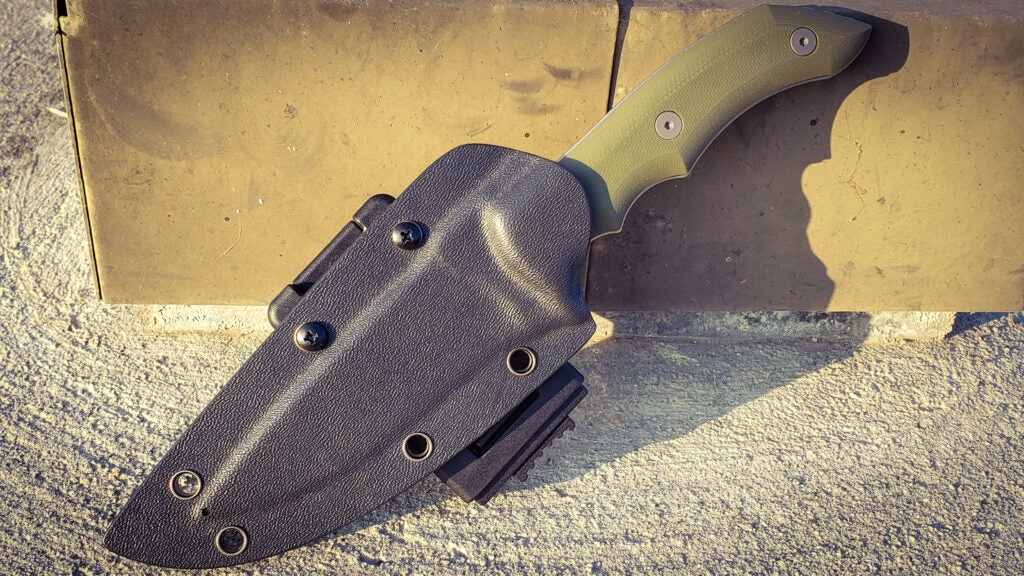
This brings us to the Stonefish itself. I opted for the 919A model of the knife, which comes with olive-drab green G10 scales on the handle, though the Stonefish is also available in black and coyote tan variants. The smooth scales are secured to the tang by three titanium T8 torx screws on each side, and appear to be lock-tited in place, as I nearly stripped a driver trying to remove one of them. The tang is referred to by the designer as a redacted tang, meaning that it intentionally extends just slightly past the scales, instead of being perfectly flush with them. This was evidently an aesthetic choice, and while it definitely gives it a sharp look, it also surprisingly added some depth to the ergonomics and overall comfort of the handle, while leaving enough of the tang exposed on the pommel to allow for use as a glass breaker or skull crusher. The tang is not skeletonized for weight reduction; however, at an overall weight of 6.49 ounces, it’s light enough for extended use, while retaining just enough weight to have a decent heft for chopping. The handle is just over half an inch thick, one inch wide, and around 4.77 inches overall in length. The tang has two separate thumb ramps with deep jimping: one located at the front of the handle for a normal saber grip, and one on the pommel for an icepick grip. The jimping is well chamfered, and not only enhances the security of your grip but also allows for correct and consistent indexing of the knife in low-light environments. The handle has two finger grooves, leading up to a decent-sized guard and finger choil, which allows for not only a very comfortable saber grip but also lets you choke up easily on the blade for finer work.
The stonewashed blade has an overall length of 4.5 inches, with a cutting edge of 3.75 inches, and is made from CPM 20CV steel. The drop-point style blade is 1.125 inches wide, with a decent belly for slicing and a very sharp point. The spine is 0.16 inches thick and narrows down through a well-executed flat-grind to a razor-sharp edge. All grinds looked symmetrical and even, which is exactly what I’ve come to expect from WE Knife Company.
How we tested the WE Stonefish
The first thing I will usually evaluate on a new knife is the quality of the factory edge. The first part of this is the hair shaving test. If the blade can shave the hair off my arm, it shows that the edge is properly apexed, which means that it’s legitimately sharp. Any knife that isn’t dull will pass this test, but a surprising amount of knives still fail this right out of the box. The Stonefish easily blitzed through the first test, shaving the hair off cleanly — no less than what I’d expect from a company as high quality as WE Knife Company. It is worth noting that the edge visually appeared to be finished at a slightly lower grit than that found on most of Cold Steel’s edges, but higher than that found on other companies like Benchmade and Spyderco.
The second part of the edge quality evaluation was to see how well it sliced through paper, which makes any imperfections in the edge painfully obvious, whether that be microchipping (small chips or nicks in the edge, usually due to abuse or a brittle heat treat) or rolling (where the edge literally bends over due to being too soft). It’ll also accentuate just how good the blade geometry is for slicing, as thicker blades tend to perform poorly. It blazed through the second test with relative ease, though I initially thought it was tearing the paper due to the angle I was holding it at. Once I figured that out, the Stonefish performed well, cutting as slowly as possible to accentuate any possible discrepancies in the edge, testing the entirety of blade from tip to choil.
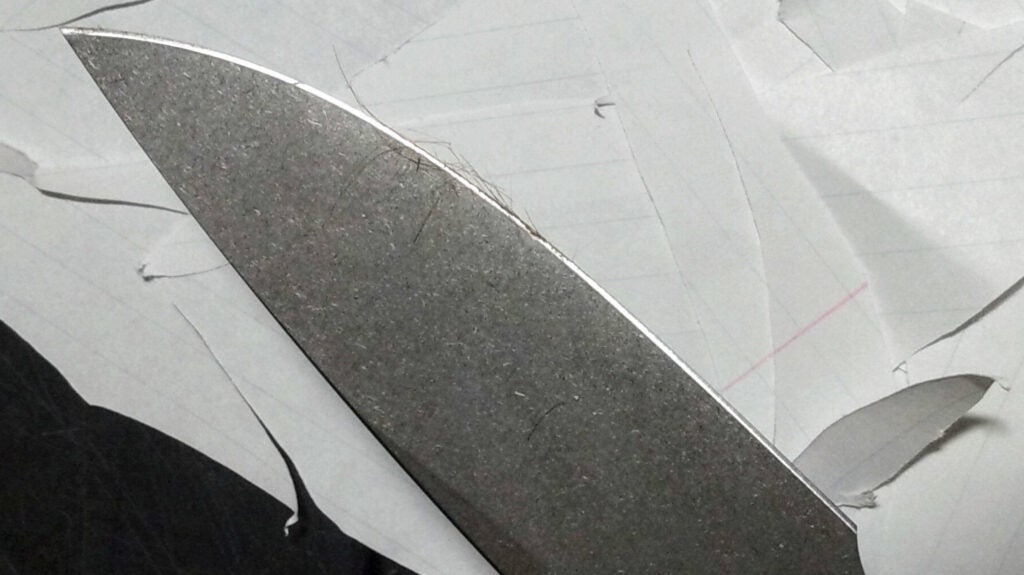
Next came the edge retention test: seeing how long the edge lasted when cutting through various mediums. Once again, I opted to use 550 paracord, as it’s very durable, frequently used in both the military and civilian worlds, and I happened to have quite a bit left over from the last test. The Stonefish performed admirably, managing a whopping 270 cuts before it started to tear paper — which makes sense, given the higher edge retention properties of CPM 20CV steel compared to something like the CPM S35VN steel in my last review. There wasn’t any visible edge deformation, and I couldn’t detect any microchipping either when I ran the tip of my fingernail along the edge.
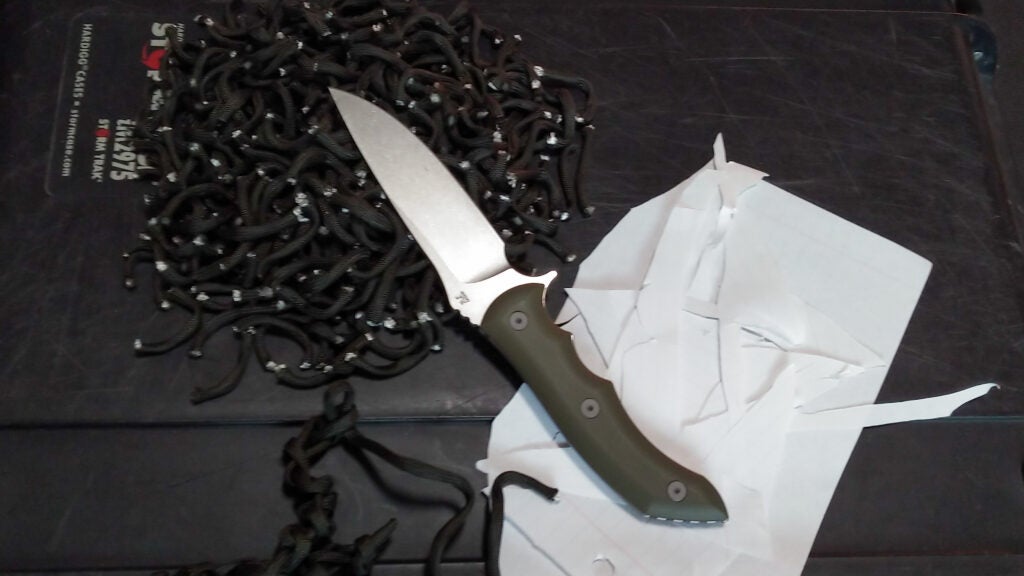
The last test I did was the blade geometry test — seeing how slicey the knife is. The WE Stonefish is a medium-sized fixed blade designed with a focus on utility and defensive uses, so it’s not what I’d consider a thin knife. Nonetheless, it does feature a full flat ground blade, so I used it to cut four large slices off a Fuji apple. Thinner blades like Spyderco’s full flat ground Para Military 2 are typically able to slice through easily, without causing any cracks in the apple slice. The Stonefish did surprisingly well in this test, with only one out of the four slices getting a single crack in it. I’m fairly certain that was my fault, as I accidentally pushed too hard and forced the knife through, slamming it into the wooden cutting board. It’s worth noting that there wasn’t any visible edge deformation after any of this, attesting to WE Knife Company’s quality heat treat.
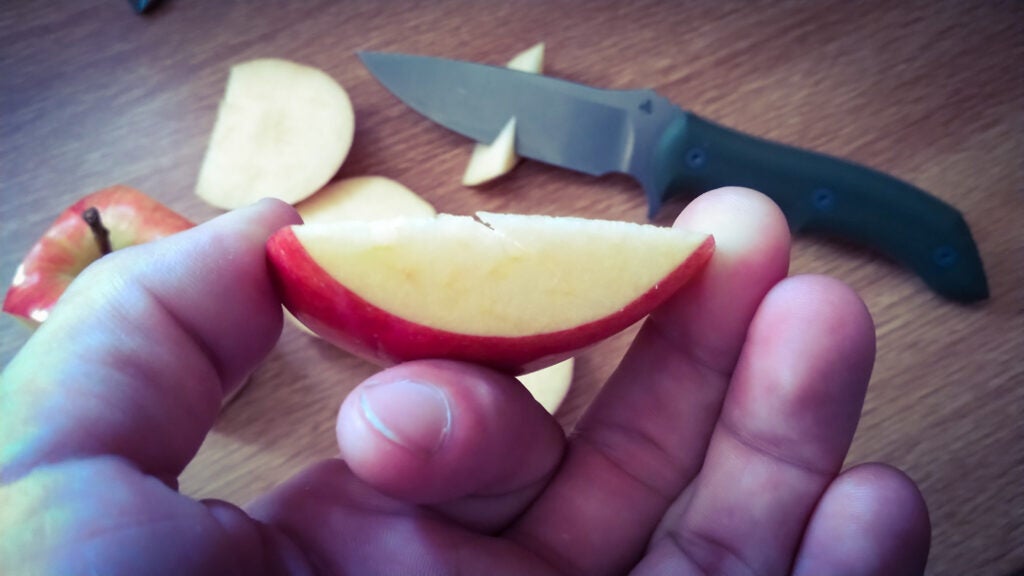
In addition to these distinct tests, I carried the Stonefish scout carry on my back every day for two weeks, and found it to be fairly comfortable and low profile, despite the Dots clip making the sheath stick out further from my belt than something lower profile, such as soft loops or even paracord. I had zero retention issues with the sheath, and the Dots clip was extremely fast and convenient for quickly donning or doffing the sheath.
What we like about the WE Stonefish
From the pleasantly understated packaging to the premium materials and aesthetic design of the knife, the WE Stonefish came dressed to impress. Throughout testing, carrying, and using the knife, I found the ergonomics were fantastic, and I especially enjoyed utilizing the comfortable finger choil, with the guard acting as a sort of sub-hilt. The edge retention was no less than I’d expect from such high-end steel, and the full flat grind was surprisingly slicey despite the thickness of the spine. I also appreciated the wide range of viable carrying positions thanks to the multiple mounting points on the sheath and the versatile Dots clip. The knife was just long enough to be functional for any task I came across, while it was short enough with an overall length of 9.23 inches to not get caught on anything while scout carrying it.
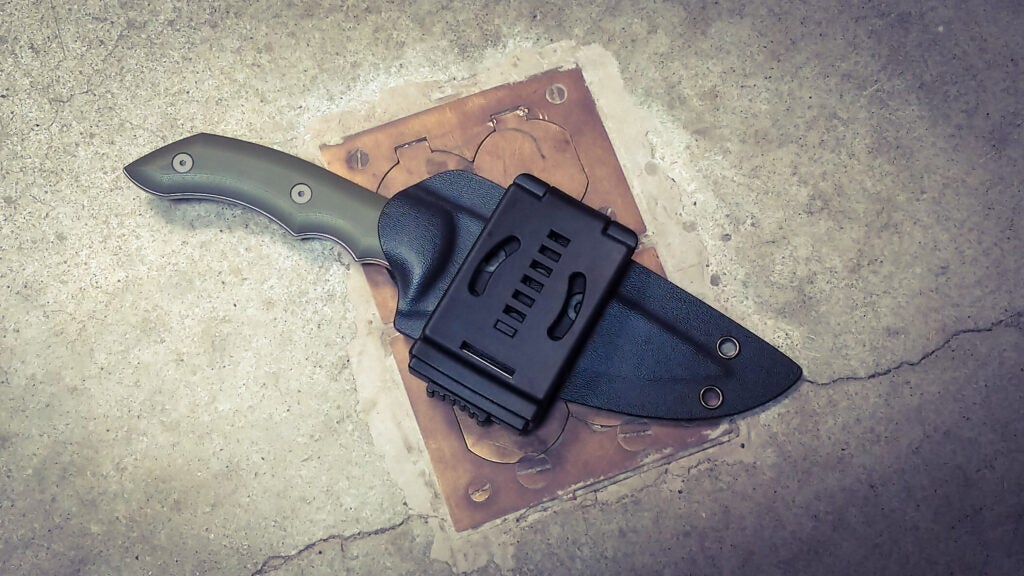
What we don’t like about the WE Stonefish
While I enjoyed this knife quite a bit, it’s worth pointing out that it’s a little on the pricier side, coming in at around $250. While that isn’t overpriced for a high-quality CNC-machined blade made from a chunk of premium steel, it looks misleadingly disproportionate when compared to more common offerings in less expensive, traditional steel. Overall, if you’re looking for a quality, long-lasting knife with good corrosion resistance and excellent edge retention, you’ll get what you pay for. While there is potential for the Dots lock to jam from dirt in the mechanism, it’s not a huge concern; if it did get jammed, it would be jammed in the closed position, which would merely secure it to your belt or gear. The only legitimate issue I have with this knife is one that is unfortunately common for fixed blades with Kydex or polymer sheaths: Careless sheathing or unsheathing of the knife can allow the edge to impact the sheath, which over time can dull the edge. It’s not an issue if you consistently ride the spine of the knife in and out of the sheath, as that will keep the edge as far from contacting the sheath as possible. Unfortunately, I experienced some deformation to the edge after letting a few other Marines examine the Stonefish, as they weren’t aware of this. While my heart dropped a little seeing that, the edge itself remained fully functional and able to slice through paper without a hitch.
Verdict
I was a little leary initially about spending so much money on a fixed blade knife, seeing as my previous fixed blade was less than $50; however, the WE Stonefish quickly proved its worth. People who prefer American-made products might shy away from buying from a Chinese company, but I’d strongly advise against devaluing the knife off of that flawed metric. Bluntly put, the quality control of many American knife companies sucks, and those that do have good quality control have a price to reflect that. At the end of the day, this is an American design, produced by one of the leading knife companies, and it helps support a small American business. From the precision machining to the overall aesthetics to its fantastic cutting performance, I was very impressed, and I look forward to seeing more designs from Michael Emler in the future.
Saved rounds
At the time of writing, the WE Stonefish can still be found in stock at most knife retailers; however, there are currently no plans to do more than a single run. Meaning: buy ’em while they’re hot because once they’re gone, they can’t be got!
FAQs about the WE Stonefish
More questions? Here’s Task & Purpose’s additional brief.
Q. How much does the WE Stonefish cost?
A. WE Knife Company’s MSRP is $294, but the Stonefish can frequently be found for less than $250 on Amazon or through most knife retailers.
Q. What is CPM 20CV steel?
A. Commonly referred to simply as 20CV, CPM stands for Crucible Particle Metallurgy, and is used by Crucible Industries to produce steel with a much finer, uniform grain structure that can allow for higher-quality alloys with drastically improved toughness and wear resistance. 20CV is tool steel made through this process and has a very similar composition to Bohler M390 and Carpenter 204P steel. It is a martensitic stainless steel with a high vanadium carbide count for exceptional wear resistance and has a very high chromium content for fantastic corrosion resistance.
Q. What is a finger choil?
A. A finger choil is usually a small half-circle right between the handle and where the edge starts. It has two main purposes: to allow the user to grip higher up on the knife for more detailed work, and to allow for easier resharpening.
Q. What is G10?
A. G-10 is a composite material made from fiberglass soaked in epoxy resin, and cured under both pressure and heat. It’s known for being wear, temperature, and moisture resistant, and has a tensile strength of over 35,000 PSI. As such, it’s an extremely popular choice for handle material for both knives and firearms.
Q. What is Kydex?
A. Kydex is a thermoplastic acrylic-polyvinyl chloride material, originally developed in 1965 by Rohm and Haas for use in the interiors of aircraft. With an HRC of 90 and its grained surface texture, it has impressive scratch and wear resistance. It’s water, flame, and chemical resistant, and is frequently used for sheaths for both knives and firearms due to its low friction coefficient and how easy it is to mold with heat.
We’re here to be expert operators in everything How-To related. Use us, compliment us, tell us we’ve gone full FUBAR. Comment below and let’s talk! You can also shout at us on Twitter or Instagram.
Our gear section
Josiah Johnston is an active duty Marine stationed at Camp Pendleton, originally from the Eastern Panhandle of West Virginia. He’s dabbled in blacksmithing, martial arts, competitive shooting, and is a self-described knife nerd.
Task & Purpose and its partners may earn a commission if you purchase a product through one of our links. We independently evaluate gear by putting products in the hands of subject matter experts. The products We test may be purchased by Task & Purpose, our staff, or provided for review by a manufacturer. No matter the source, our testing procedures and our assessments remain free from third-party influence. Learn more about our product review process.
